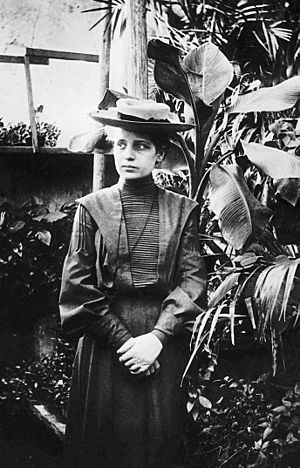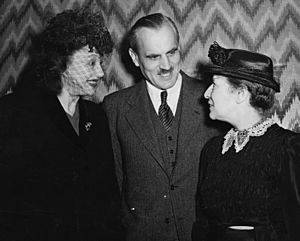Lise Meitner facts for kids
Quick facts for kids
Lise Meitner
|
|
|---|---|
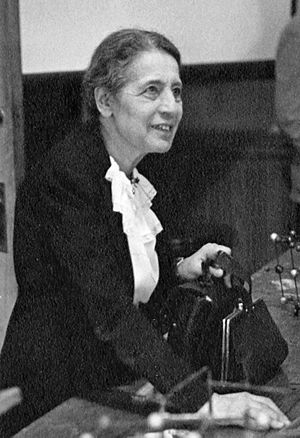
Lise Meitner in 1946
|
|
| Born | 7 November 1878 |
| Died | 27 October 1968 (aged 89) Cambridge, England
|
| Citizenship | Austria (pre-1949), Sweden (post-1949) |
| Alma mater | University of Vienna |
| Known for | Nuclear fission |
| Awards |
|
| Scientific career | |
| Fields | Physics |
| Institutions | Kaiser Wilhelm Institute University of Berlin, Manne Siegbahn Laboratory University College of Stockholm |
| Doctoral advisor | Franz S. Exner |
| Other academic advisors | Ludwig Boltzmann Max Planck |
| Doctoral students | Arnold Flammersfeld Kan-Chang Wang Nikolaus Riehl |
| Other notable students | Max Delbrück Hans Hellmann |
| Influenced | Otto Hahn |
| Signature | |
Lise Meitner (born Elise Meitner, 7 November 1878 – 27 October 1968) was an Austrian-Swedish physicist. She was a key scientist in the discovery of the element protactinium. She also helped discover nuclear fission, which is how atoms can be split. This discovery led to the creation of nuclear power and atomic bombs. Albert Einstein called her the "German Marie Curie" because of her important work.
Contents
Early Life and Family
Lise Meitner was born Elise Meitner on November 7, 1878, in Vienna, Austria. She was one of eight children in a Jewish family. Her father, Philipp Meitner, was one of the first Jewish lawyers in Austria. Lise was raised to think freely and question things. Later in her life, she became a Christian and was baptized in 1908. She also shortened her name to "Lise."
Becoming a Scientist
Lise Meitner loved science and math from a young age. She started keeping a science notebook when she was only eight years old. At that time, women in Vienna were not allowed to go to public universities until 1897. Because of this, Lise first trained to be a French teacher, which was one of the few jobs open to women.
Studying Physics
In 1899, Lise began taking private lessons to catch up on her high school education. She studied for eight years of school in just two! In 1901, she passed a difficult exam and entered the University of Vienna. She was especially inspired by her physics professor, Ludwig Boltzmann. Lise earned her doctoral degree in physics in 1906. She was only the second woman to do so at the University of Vienna.
Early Discoveries
After getting her degree, Lise continued to do research. She studied how light behaves and how tiny particles scatter. She was introduced to radioactivity, which was a very new field of science then. Her work with alpha particles helped other scientists, like Ernest Rutherford, understand the structure of the nuclear atom.
A Career in Science
Lise Meitner spent most of her career in Berlin, Germany. She became a physics professor and led a department at the Kaiser Wilhelm Institute. She was the first woman to become a full professor of physics in Germany. However, in the 1930s, she lost her job because of the Nuremberg Laws in Nazi Germany, which discriminated against Jewish people. In 1938, she had to leave Germany and moved to Sweden. She lived there for many years and became a Swedish citizen.
Discovering Nuclear Fission
In 1938, Lise Meitner worked with chemists Otto Hahn and Fritz Strassmann. They were studying what happens when you bombard elements like thorium and uranium with tiny particles called neutrons. Hahn and Strassmann found that bombarding uranium could create lighter elements like barium.
In late 1938, Meitner and her nephew, physicist Otto Robert Frisch, figured out what was happening. They realized that the uranium atom was splitting into two smaller atoms. They called this process "fission." This amazing discovery was published in the journal Nature in 1939.
Impact of Her Work
The discovery of nuclear fission was incredibly important. It led to the development of the first atomic bomb during World War II. It also made nuclear reactors possible, which are used to generate electricity.
After the atomic bomb was dropped on Hiroshima, Lise Meitner became famous. She was interviewed by Eleanor Roosevelt and lectured at top universities like Princeton University and Harvard University. She also discussed physics with other great minds like Albert Einstein.
Nobel Prize Controversy
Lise Meitner did not share the 1944 Nobel Prize in Chemistry for nuclear fission. The prize was given only to her long-time partner, Otto Hahn. Many scientists and journalists felt this was unfair. Meitner was nominated for the Nobel Prize many times in both chemistry and physics, but she never won.
Despite not receiving the Nobel Prize, Lise Meitner received many other awards and honors. In 1997, chemical element 109 was named meitnerium after her. She is the first and only non-mythological woman to have an element named exclusively in her honor.
Later Life and Legacy

Lise Meitner retired in 1960 and moved to the United Kingdom to be closer to her family. She continued to work part-time and give lectures.
In 1964, a difficult trip to the United States caused her to have a heart attack. Her health slowly got worse. After a fall and several small strokes, she moved into a nursing home. Lise Meitner passed away peacefully in her sleep on October 27, 1968, at the age of 89.
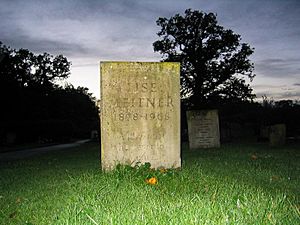
She was buried in the village of Bramley, England, near her younger brother Walter. Her nephew, Otto Robert Frisch, wrote the words on her headstone:
Lise Meitner: a physicist who never lost her humanity.
Awards and Honors

Lise Meitner received many awards during her lifetime. In 1946, she was named "Woman of the Year" by the National Press Club in the United States. She also had dinner with the President of the United States, Harry S. Truman.
She received the Max Planck Medal in 1949 and the Otto Hahn Prize in 1954. In 1957, the President of Germany gave her the highest German award for scientists, the Pour le Mérite.
In 1966, Lise Meitner, Otto Hahn, and Fritz Strassmann were jointly given the Enrico Fermi Award. This was a very important award from the United States Atomic Energy Commission. It was the first time this prize was given to non-Americans and the first time it was given to a woman.
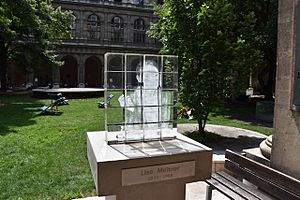
After her death, many things were named in her honor. Besides the element meitnerium, there is the Hahn–Meitner-Institut in Berlin, craters on the Moon and Venus, and an asteroid. The European Physical Society created the "Lise Meitner Prize" for excellent research in nuclear science. Schools and streets in Austria and Germany are also named after her.
In 2014, a statue of Lise Meitner was placed in the garden of the Humboldt University of Berlin, next to statues of other famous scientists. In 2020, a satellite was launched into space and named "Lise" after her.
Images for kids
See also
 In Spanish: Lise Meitner para niños
In Spanish: Lise Meitner para niños


